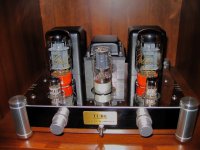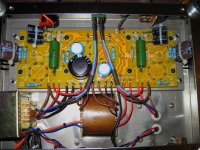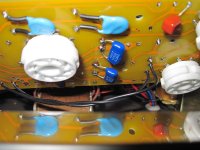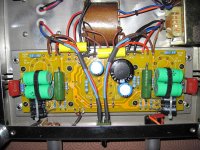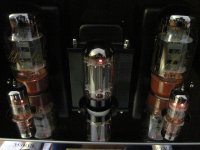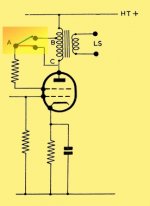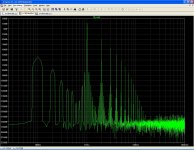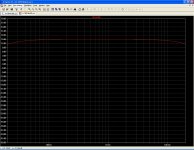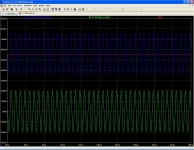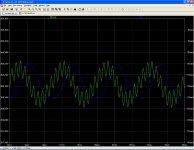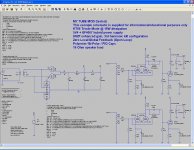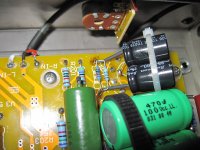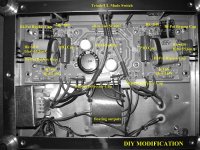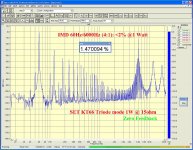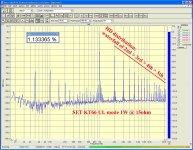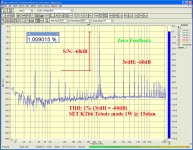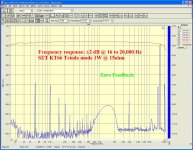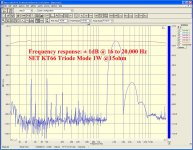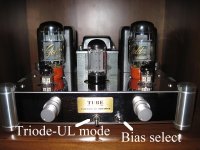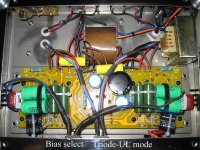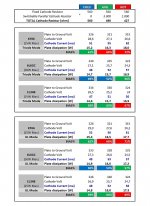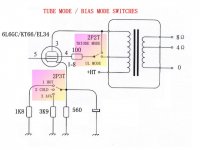I admit I was highly reluctant to buy a Chinese product, like most of the people in my country, but at the end I did it, and have absolutely no regrets: this Chinese tube amps is probably one the biggest bargains in the audio world.
Description:
12Wx2 EL34B+6N2 SE Tube Amplifier with 5Z4P rectifier
Official Features:
- Input voltage: 220V
- Power supply: 160W
- Output power: 12W x 2 (ultra-linear connection)
- Frequency response: 20Hz - 28KHz
- military grade dual triode 6N2J as voltage amplifier
- Shuguang EL34B as power tube
- Shuguang 5Z4PJ as rectifier
- THD: <1% @ 1KHz
- Output impedance: 4Ohm and 8Ohm
- Input Impedance: 100KOhm (two input signals)
- Input sensitivity: 750mV
- SNR: >88dB
- Power transformer: 96x50mm 0.35mm z11 using imported 96mm slicone steel plates in 0.35mm thickness,Stack thickness is 50MM to ensure sufficiant power and low heating.
- Output transformer: 66x36mm 0.35mm z11 using 66mm slicone steel plates in 0.35mm thickness,Stack thickness is 36MM.
- Mirror surface stainless steel enclosure
- Diamond cutting corner feet
- Alps potentiometer
- Powder coating transformer enclosure
- Dimension: LxWxH 310×268×165mm
- Weight: 12Kg
- Price c.a. $250.00 + $110.00 shipment (purchased at 300 euro in Italy)
Additional circuital info:
-PRO: really amazing quality/price ratio: this amplifier has without any doubt a superb design for its price
-PRO: The mids are clean and the bass/highs are all there (I'm listening with 16 ohms fullrange loudspeakers). Not too much bright (which I really like), it sounds quite veiled and rolled-off (with stock EL34) but sufficiently detailed, thus there is no way you will get ears fatigue with this tube amp
-PRO: voltage amplifier with triodes in parallel to reduce noise and increase gain
-PRO: hybrid bridge rectifier using a valve rectifier and a pair of silicon diodes. You will still get the valve sound without the harshness of the silicon diode cutoff in reverse bias.
-PRO: choke is used as a power supply filter element
-PRO: Panasonic, Philips and Nichicon brand capacitors
-PRO: all components are well dimensioned and never run hot
-PRO: PCB and very clean wiring
-PRO: safety: the amplifier is internally correctly grounded/earthed
-CONS: the noise floor is quite poor, but this noise is modest and does not at all interfere with the listening
-CONS: missing 16 ohm output
-CONS: missing EL34 grid stopper resistor
-CONS: the inside iron core inductor looks not to be well fixed to the chassis (only from one side), which, I think, could be a problem if you think to a very long shipping distance
-CONS: shipping box content is minimal, that is just the amplifier without brand, marks or labels and no documentation (but this is fully justified by the price)
______________________________________________________________________________________________________________
MAJOR IMPROVEMENTS OF MINE (have immediately void the warranty!):
1) Stock version: Ultra-Linear mode connection only
Modification: added front panel “bright chrome” switch to select between Triode and Ultra-Linear mode
Triode mode is more pure, with less distortion and more open sound but the UL has more power and dynamic...it is your liking. In every amp with user-switchable triode/ultralinear circuits, triode usually sounds better.
2) Stock version: EL34B power tubes
Modification: replaced with KT66 power tubes
No self-bias adjustment is required (according to Weber Bias Calculator) since KT66 has the same plate dissipation than EL34 (25W), but KT66 has higher load impedance requirement than EL34. That is also recommended if you run, like me, a 16 ohm speaker to the 8 ohm output since you are doublig the reflected impedance. Optimal burn-in times range from 100 to 300 hours. Most changes are happening in the first 150 hours. Also the 6L6GC high-power tubes have high internal impedance and work great in this amplifier on a 16 ohm load without requiring bias adjustment since exhibit similar consumptions to the EL34B (see last page measurements).
3) Stock version: two 1N4007 (in the hybrid power supply)
Modification: replaced with two ultra-fast SF4007 diodes, bypassed by 10nF snubbing caps
Walt Jung article gives the reasons for using fast recovery diodes and has actual measurements showing the large amount of RF hash generated by common 400x rectifiers.
4) Stock version: 220uf Panasonic Electrolytic (FC Series) cathode bypass capacitor (in the power output stage)
Modification: replaced with bipolar Sic-Safco 470+470uF back-to-back (+--+) capacitors, plus 2u2F polyester cap
Many folks have found that Bipolar Electrolytic Capacitors can make a noticeable difference when used as cathode bypass capacitors in tube amps. Read "Bipolar Electrolytic Capacitors" by Matt Seniff.
5) Stock version: unbypassed gain bias resistor (in the common-cathode triode amplifier)
Modification: added bypass cathode capacitor (bipolar Rubycon 1000+1000uF back-to-back (+--+) capacitors, plus 1uF polyester cap)
By adding bypass cathode capacitor you increase gain (recommended by KT66’s higher gain requirements) and rise mostly even harmonics. Being an even order harmonic, this is not a critical tonal issue, since even order harmonics stay musical (multiples of an octave).
6) Stock version: 220nF/400V Philips (MKT series) coupling capacitor between stages
Modification: replaced with 220nF/500V metallized paper-in-oil K42Y-2 Soviet Military Capacitor
PIO dielectrics are appreciated for their tonal balance that is very neutral and smooth. Audiophiles, studio guys, vintage collectors can all hear the difference with their own opinions on what is best. The main thing is that I agree that the cap upgrade is a good thing.
7) Modification: added bypass film 1uF/47nF capacitors in power supply (on the back side of the PCB) in parallel to electrolytics to filter out high frequency noise.
8) Stock version: three-pronged power cord with ground (earth) connected to the chassis
Modification: remove earth connection by plugging into a continental power adaptor which breaks the ground (earth)
By removing earth connection, the amplifier sounds quieter and better.
9) Stock version: no Global Negative Feedback
No Modification: give up to any Local/Global Negative Feedback
I tried from -1 to -6dB of NFB which makes a great influence in the final sound, but additional NFB made the amplifier sounding more and more as "solid-state". I preferred the stock version (no GNFB at all) since it sounds more harmonically rich which results pleasant to me.
10) Stock version: for safety reasons the common (or zero ohm) end of the OPT is grounded
Modification: floating outputs, and separated isolated L/R zero ohm returns
Amplifiers with no global feedback can leave the output transformer secondary floating, even if it is electrically unsafe. This opens the soundstage a little bit. Probably the floating outputs provides the (RF) noise-reduction benefits of balanced lines.
11) Stock version: EL34B self-biased at plate dissipation of about 15W (out of 25W max) by 500 ohm cathode resistor. That means cold/average dissipation.
Modification: KT66 self-biased at plate dissipation of nearly 19W (out of 25W max) by a reduced 410 ohm cathode resistor. That means hot dissipation.
Biasing the power tubes hot gives it a brighter and fuller sound.
12) Stock version: 5Z4 rectifier
Modification: replaced with Sovtek 5V4 rectifier (or even JJ GZ34)
The KT66s’ new adjusted bias is now drawing extra current, about 120ma, so too much close the maximum forward current of the 5Z4 (125ma max, 350V, 20V drop). The replacement with 5V4 (175ma max, 375V, 25V drop) or with GZ34 (250ma max, 450V, 17V drop) is just recommended because both tubes are low drop-out equivalents. At the end, after listening test, I even prefer 5V4 to the GZ34, probably due to the highest voltage drop and sag: the GZ34 is too close to “solid state” in the response and in some cases it yields voices quite metallic and fuzzy, for sure never as smooth and natural as delivered with the 5V4. Of course by using the 5V4 makes the KT66s running a bit less hot due to the higher drop in power voltage supply.
13) Stock version: the shared cathode resistor of the parallel 6N2 triodes is Rk= 2Kohm
Modification: triodes in the driver stage are re-biased hotter (Rk=840ohm)
The optimal plate load for a triode is around two to three times the plate resistance (which is nearly 47Kohm for the 6N2), thus the stock anode resistor looks well-dimensioned and I didn’t modify its value (75Kohm). Remember that parallel operation needs shared plate and cathode resistors at half the single triode value.
Pay attention that 6N2J (or 6N2P, 6N2P-EV) is not full equivalent to ECC83 (or 12AX7): both have an amplification factor nearly of 100, but, a part of the filament connections, the last has higher plate resistance (62.5Kohm) and slight shifted grid-voltage vs. cathode-current curves.
Since 6N2 triodes are now bypassed by a capacitor for a higher gain, changing the cathode resistor doesn’t modify the voltage gain, but only shifts the bias point: this modifies the headroom of the driver stage and the distortion level. As the bias point is shifted, the amplifier will clip more on the top or bottom portion of the waveform.
By lowering the cathode resistor from 2K to 840ohm, not only we increase and better centre the bias current, but also we obtain a better sounding harmonic distribution, the so called waterfall of 2nd > 3rd > 4th > 5th. Cathode resistor value was in fact chosen where the measured third harmonic component was minimum and the second harmonic dominant at an output power of 1 Watt. The soundstage turned out to be more "open" and "natural" that confirms all Psychoacoustics studies which say that even harmonics give a warmer, organic, and natural sound while odd harmonics impart a more harsh and metallic sound.
14) Added a Zobel RC network between the amp and the full-range 16 ohm speaker
Any amp is inductively loaded by a speaker, so the correct form for interpreting an inductive load on a plate current/voltage curve is an ellipse which may exceed the Max dissipation curve limit. A Zobel RC Network is designed to achieve a flat impedance, safer load.
This amplifier looks to sound more comfortable driving a flat-impedance resistive-like 16 ohm load, (from its 8 ohm output taps), which results in a better 3D image and stable focus
15) Stock version: input grid stopper resistor (in series with the grids of the driver triodes) is 10Kohm
Modification: input grid stopper resistor lowered to 3.3Kohm
The stock input stopper grid resistor is 10Kohm (but the triode, originally unbypassed, had a lower voltage gain of nearly 20). After bypassing the common cathode resistor of the parallel driver triodes for a higher gain, the voltage gain reaches nearly 70, and the grid resistor needs to be reduced of about one third, from 10K to 3.3K, due to the increased input Miller capacitance.
In fact the Miller capacity (that is twice for parallel triodes) is:
Cin = Cgk + Cgp*(A+1) =~ Cgp*(A+1) =~ Cgp*21 (when unbypassed)
or
=~ Cgp*71 (if bypassed)
then, Cin_bypassed =~ 71/21 Cin_unbypassed =~ 3.3 Cin_unbypassed thus, Cin_bypassed =~ three times Cin_unbypassed
The input capacitance of the tube (Cin), in conjunction with the impedance of the grid stopper resistor (Rg), forms a simple RC lowpass filter with a -6dB/octave slope. To maintain the original low roll-off frequency, Rg resistor should be reduced to one third, since Cin has been tripled. Frequency response is now back to be ± 1dB at 16 to 20000Hz.
16) Stock version: the interstage coupling capacitor is C=220nF and the KT66/EL34 grid leak resistor is R=470Kohm. Also the 6N2 grid leak resistor is R1=470Kohm.
Modification: coupling capacitor doubled to 440nF and KT66/EL34 grid resistor halved to 220Kohm, preserving the original RC cut-off frequency. The 6N2 grid leak resistor is cut from 470Kohm to 150Kohm.
A lower value grid leak resistor will be harder to drive, but will give a more constant load at different frequencies, and hence a more extended high frequency performance. In fact, the grid to plate internal capacitance of the following stage (whose value is also multiplied by the gain of the stage, due to the Miller effect) reinjects a fraction of the output signal back to the grid. It is nothing else that a local negative feedback whose effect increases with frequency and the gain. The Miller effect can cause loss of treble if the grid resistor is too high; the lowest the grid leak resistor, the lowest the feedback, the wider the bandwith. Miller capacitance not only affects high frequency response but it adds phase intermodulation distortions as well.
By halving the size of the grid leak resistor, we double the cut-off frequency and increase it by an octave, cutting the bass response. Viceversa, by doubling the size of the interstage coupling capacitor we halve the cut-off frequency and reduce it by an octave, allowing more bass response. By choosing a lower value of the grid leak resistors, we also lower the gain a tad, but not significantly. If we make both the modifications, the two effects will compensate each other, maintaining the original RC time constant, thus the original the cut-off frequency.
It is important that we should always aim for a corner frequency of one tenth of 20Hz (2 Hz) to avoid any phase shift in the lowest bass region.
We can easily double the existing capacitance by putting another identical capacitor in parallel. Putting two identical caps in parallel is a good thing and brings small advantages because we halve the intrinsic resistance and the cap's inductance.
Many folks have done intensive testing of input capacitors: parallel film capacitors sound better to their ears as they were found to sound "faster" than a single capacitor of the same value, but we are straying into highly subjective territory here.
Moreover, we could test to put a "PIO" together in parallel with a film and foil capacitor of the same value to create a tone circuit, because a pure PIO capacitor has been found to sound smooth but rolled off in the highs.
The output impedence for two 6N2 parallelled triodes (output taken from the plates, bypassed cathodes) is about:
Rs= Ra/2||Rp/2 = 47K/2||150K/2 = 23.5K||75K = 17.9Kohm
The impedance of the following stage (KT66/EL34) is just the grid resistor reduced to R= 470K/2~ 220Kohm.
The coupling interstage capacitor has been increased to C=0.22x2= 0.44uF
The new cut-off frequency at -3dB of the low end of the band will result equal to 1/[2*pi*(Rs+R)*C]= 1.5Hz, that is a desired pole frequency less than one tenth of 20Hz.
To change the grid leak resistors brings major tonal improvement to the tube amplifier, creating a soundstage with focus and realism.
17) Stock version: single value of cathode bias resistor on power tubes
Modification: added a front panel “bright chrome” switch to select among three different BIAS options: HOT, AVERAGE and COLD
This three-positions switch allows you to select among different cathode resistors (connected in parallel) that determine three different BIAS currents and consequently let run the power tubes slight colder or slight hotter than the average.
In Single Ended amplifiers (which always run in Class A, ergo do not suffer from crossover distortion) decreasing or increasing the bias current brings little tonal improvement due to the asymmetrical clipping and waveform compression which increases the content of the second harmonic distortion and enhances its ratio compared to the third and odd harmonics.
Bias adjustment is highly recommended after having swapped different tubes or after having switched between Triode and UL mode: you can observe in the attached table that various tubes (EL34/6L6GC/KT66) show slight different measured voltages and consumptions, thus exhibit distinctive tonal behaviours.
Hot bias shortens tube life and usually sounds more dynamic and fuller, but potentially harsher. On the other side, cold bias, for which tubes will last longer, in certain circumstances produces more natural tones, even if sometimes the sound results thin and lifeless.
_________________________________________________________________________________________________________________
Attached curves of the A10 amplifier after all my modifications, both simulated via LTSpice and measured on a PC-soundcard.
I measured a maximum power of 3.5 Watt on 15 ohms (10% THD) in Triode mode and 6 Watt in the Ultralinear operation, both channels working.
I would not comment the curves since I think almost everything is self-explanatory: I just ask you to bear in mind the mismatched impedance between the amp and speakers (I’m running a 16 ohm cab through the 8 ohm amp tap) and that now there is neither global nor local negative feedback in the triode mode, and just a negative feedback applied to the screen grid in the ultralinear operation.
I can't disguise the fact that the ZERO LOCAL/GLOBAL FEEDBACK TRIODE CONFIGURATION satisfies me completely regardless of the higher distortion and lower power output.
ANY COMMENTS ARE WELCOME!

 My Homemade Tube Amplifier website: The Sound Grail, design, schematic, simulation and measurements http://tubeamplifiers.wixsite.com/thesoundgrail
My Homemade Tube Amplifier website: The Sound Grail, design, schematic, simulation and measurements http://tubeamplifiers.wixsite.com/thesoundgrail 

Description:
12Wx2 EL34B+6N2 SE Tube Amplifier with 5Z4P rectifier
Official Features:
- Input voltage: 220V
- Power supply: 160W
- Output power: 12W x 2 (ultra-linear connection)
- Frequency response: 20Hz - 28KHz
- military grade dual triode 6N2J as voltage amplifier
- Shuguang EL34B as power tube
- Shuguang 5Z4PJ as rectifier
- THD: <1% @ 1KHz
- Output impedance: 4Ohm and 8Ohm
- Input Impedance: 100KOhm (two input signals)
- Input sensitivity: 750mV
- SNR: >88dB
- Power transformer: 96x50mm 0.35mm z11 using imported 96mm slicone steel plates in 0.35mm thickness,Stack thickness is 50MM to ensure sufficiant power and low heating.
- Output transformer: 66x36mm 0.35mm z11 using 66mm slicone steel plates in 0.35mm thickness,Stack thickness is 36MM.
- Mirror surface stainless steel enclosure
- Diamond cutting corner feet
- Alps potentiometer
- Powder coating transformer enclosure
- Dimension: LxWxH 310×268×165mm
- Weight: 12Kg
- Price c.a. $250.00 + $110.00 shipment (purchased at 300 euro in Italy)
Additional circuital info:
-PRO: really amazing quality/price ratio: this amplifier has without any doubt a superb design for its price
-PRO: The mids are clean and the bass/highs are all there (I'm listening with 16 ohms fullrange loudspeakers). Not too much bright (which I really like), it sounds quite veiled and rolled-off (with stock EL34) but sufficiently detailed, thus there is no way you will get ears fatigue with this tube amp
-PRO: voltage amplifier with triodes in parallel to reduce noise and increase gain
-PRO: hybrid bridge rectifier using a valve rectifier and a pair of silicon diodes. You will still get the valve sound without the harshness of the silicon diode cutoff in reverse bias.
-PRO: choke is used as a power supply filter element
-PRO: Panasonic, Philips and Nichicon brand capacitors
-PRO: all components are well dimensioned and never run hot
-PRO: PCB and very clean wiring
-PRO: safety: the amplifier is internally correctly grounded/earthed
-CONS: the noise floor is quite poor, but this noise is modest and does not at all interfere with the listening
-CONS: missing 16 ohm output
-CONS: missing EL34 grid stopper resistor
-CONS: the inside iron core inductor looks not to be well fixed to the chassis (only from one side), which, I think, could be a problem if you think to a very long shipping distance
-CONS: shipping box content is minimal, that is just the amplifier without brand, marks or labels and no documentation (but this is fully justified by the price)
______________________________________________________________________________________________________________
MAJOR IMPROVEMENTS OF MINE (have immediately void the warranty!):
1) Stock version: Ultra-Linear mode connection only
Modification: added front panel “bright chrome” switch to select between Triode and Ultra-Linear mode
Triode mode is more pure, with less distortion and more open sound but the UL has more power and dynamic...it is your liking. In every amp with user-switchable triode/ultralinear circuits, triode usually sounds better.
2) Stock version: EL34B power tubes
Modification: replaced with KT66 power tubes
No self-bias adjustment is required (according to Weber Bias Calculator) since KT66 has the same plate dissipation than EL34 (25W), but KT66 has higher load impedance requirement than EL34. That is also recommended if you run, like me, a 16 ohm speaker to the 8 ohm output since you are doublig the reflected impedance. Optimal burn-in times range from 100 to 300 hours. Most changes are happening in the first 150 hours. Also the 6L6GC high-power tubes have high internal impedance and work great in this amplifier on a 16 ohm load without requiring bias adjustment since exhibit similar consumptions to the EL34B (see last page measurements).
3) Stock version: two 1N4007 (in the hybrid power supply)
Modification: replaced with two ultra-fast SF4007 diodes, bypassed by 10nF snubbing caps
Walt Jung article gives the reasons for using fast recovery diodes and has actual measurements showing the large amount of RF hash generated by common 400x rectifiers.
4) Stock version: 220uf Panasonic Electrolytic (FC Series) cathode bypass capacitor (in the power output stage)
Modification: replaced with bipolar Sic-Safco 470+470uF back-to-back (+--+) capacitors, plus 2u2F polyester cap
Many folks have found that Bipolar Electrolytic Capacitors can make a noticeable difference when used as cathode bypass capacitors in tube amps. Read "Bipolar Electrolytic Capacitors" by Matt Seniff.
5) Stock version: unbypassed gain bias resistor (in the common-cathode triode amplifier)
Modification: added bypass cathode capacitor (bipolar Rubycon 1000+1000uF back-to-back (+--+) capacitors, plus 1uF polyester cap)
By adding bypass cathode capacitor you increase gain (recommended by KT66’s higher gain requirements) and rise mostly even harmonics. Being an even order harmonic, this is not a critical tonal issue, since even order harmonics stay musical (multiples of an octave).
6) Stock version: 220nF/400V Philips (MKT series) coupling capacitor between stages
Modification: replaced with 220nF/500V metallized paper-in-oil K42Y-2 Soviet Military Capacitor
PIO dielectrics are appreciated for their tonal balance that is very neutral and smooth. Audiophiles, studio guys, vintage collectors can all hear the difference with their own opinions on what is best. The main thing is that I agree that the cap upgrade is a good thing.
7) Modification: added bypass film 1uF/47nF capacitors in power supply (on the back side of the PCB) in parallel to electrolytics to filter out high frequency noise.
8) Stock version: three-pronged power cord with ground (earth) connected to the chassis
Modification: remove earth connection by plugging into a continental power adaptor which breaks the ground (earth)
By removing earth connection, the amplifier sounds quieter and better.
9) Stock version: no Global Negative Feedback
No Modification: give up to any Local/Global Negative Feedback
I tried from -1 to -6dB of NFB which makes a great influence in the final sound, but additional NFB made the amplifier sounding more and more as "solid-state". I preferred the stock version (no GNFB at all) since it sounds more harmonically rich which results pleasant to me.
10) Stock version: for safety reasons the common (or zero ohm) end of the OPT is grounded
Modification: floating outputs, and separated isolated L/R zero ohm returns
Amplifiers with no global feedback can leave the output transformer secondary floating, even if it is electrically unsafe. This opens the soundstage a little bit. Probably the floating outputs provides the (RF) noise-reduction benefits of balanced lines.
11) Stock version: EL34B self-biased at plate dissipation of about 15W (out of 25W max) by 500 ohm cathode resistor. That means cold/average dissipation.
Modification: KT66 self-biased at plate dissipation of nearly 19W (out of 25W max) by a reduced 410 ohm cathode resistor. That means hot dissipation.
Biasing the power tubes hot gives it a brighter and fuller sound.
12) Stock version: 5Z4 rectifier
Modification: replaced with Sovtek 5V4 rectifier (or even JJ GZ34)
The KT66s’ new adjusted bias is now drawing extra current, about 120ma, so too much close the maximum forward current of the 5Z4 (125ma max, 350V, 20V drop). The replacement with 5V4 (175ma max, 375V, 25V drop) or with GZ34 (250ma max, 450V, 17V drop) is just recommended because both tubes are low drop-out equivalents. At the end, after listening test, I even prefer 5V4 to the GZ34, probably due to the highest voltage drop and sag: the GZ34 is too close to “solid state” in the response and in some cases it yields voices quite metallic and fuzzy, for sure never as smooth and natural as delivered with the 5V4. Of course by using the 5V4 makes the KT66s running a bit less hot due to the higher drop in power voltage supply.
13) Stock version: the shared cathode resistor of the parallel 6N2 triodes is Rk= 2Kohm
Modification: triodes in the driver stage are re-biased hotter (Rk=840ohm)
The optimal plate load for a triode is around two to three times the plate resistance (which is nearly 47Kohm for the 6N2), thus the stock anode resistor looks well-dimensioned and I didn’t modify its value (75Kohm). Remember that parallel operation needs shared plate and cathode resistors at half the single triode value.
Pay attention that 6N2J (or 6N2P, 6N2P-EV) is not full equivalent to ECC83 (or 12AX7): both have an amplification factor nearly of 100, but, a part of the filament connections, the last has higher plate resistance (62.5Kohm) and slight shifted grid-voltage vs. cathode-current curves.
Since 6N2 triodes are now bypassed by a capacitor for a higher gain, changing the cathode resistor doesn’t modify the voltage gain, but only shifts the bias point: this modifies the headroom of the driver stage and the distortion level. As the bias point is shifted, the amplifier will clip more on the top or bottom portion of the waveform.
By lowering the cathode resistor from 2K to 840ohm, not only we increase and better centre the bias current, but also we obtain a better sounding harmonic distribution, the so called waterfall of 2nd > 3rd > 4th > 5th. Cathode resistor value was in fact chosen where the measured third harmonic component was minimum and the second harmonic dominant at an output power of 1 Watt. The soundstage turned out to be more "open" and "natural" that confirms all Psychoacoustics studies which say that even harmonics give a warmer, organic, and natural sound while odd harmonics impart a more harsh and metallic sound.
14) Added a Zobel RC network between the amp and the full-range 16 ohm speaker
Any amp is inductively loaded by a speaker, so the correct form for interpreting an inductive load on a plate current/voltage curve is an ellipse which may exceed the Max dissipation curve limit. A Zobel RC Network is designed to achieve a flat impedance, safer load.
This amplifier looks to sound more comfortable driving a flat-impedance resistive-like 16 ohm load, (from its 8 ohm output taps), which results in a better 3D image and stable focus
15) Stock version: input grid stopper resistor (in series with the grids of the driver triodes) is 10Kohm
Modification: input grid stopper resistor lowered to 3.3Kohm
The stock input stopper grid resistor is 10Kohm (but the triode, originally unbypassed, had a lower voltage gain of nearly 20). After bypassing the common cathode resistor of the parallel driver triodes for a higher gain, the voltage gain reaches nearly 70, and the grid resistor needs to be reduced of about one third, from 10K to 3.3K, due to the increased input Miller capacitance.
In fact the Miller capacity (that is twice for parallel triodes) is:
Cin = Cgk + Cgp*(A+1) =~ Cgp*(A+1) =~ Cgp*21 (when unbypassed)
or
=~ Cgp*71 (if bypassed)
then, Cin_bypassed =~ 71/21 Cin_unbypassed =~ 3.3 Cin_unbypassed thus, Cin_bypassed =~ three times Cin_unbypassed
The input capacitance of the tube (Cin), in conjunction with the impedance of the grid stopper resistor (Rg), forms a simple RC lowpass filter with a -6dB/octave slope. To maintain the original low roll-off frequency, Rg resistor should be reduced to one third, since Cin has been tripled. Frequency response is now back to be ± 1dB at 16 to 20000Hz.
16) Stock version: the interstage coupling capacitor is C=220nF and the KT66/EL34 grid leak resistor is R=470Kohm. Also the 6N2 grid leak resistor is R1=470Kohm.
Modification: coupling capacitor doubled to 440nF and KT66/EL34 grid resistor halved to 220Kohm, preserving the original RC cut-off frequency. The 6N2 grid leak resistor is cut from 470Kohm to 150Kohm.
A lower value grid leak resistor will be harder to drive, but will give a more constant load at different frequencies, and hence a more extended high frequency performance. In fact, the grid to plate internal capacitance of the following stage (whose value is also multiplied by the gain of the stage, due to the Miller effect) reinjects a fraction of the output signal back to the grid. It is nothing else that a local negative feedback whose effect increases with frequency and the gain. The Miller effect can cause loss of treble if the grid resistor is too high; the lowest the grid leak resistor, the lowest the feedback, the wider the bandwith. Miller capacitance not only affects high frequency response but it adds phase intermodulation distortions as well.
By halving the size of the grid leak resistor, we double the cut-off frequency and increase it by an octave, cutting the bass response. Viceversa, by doubling the size of the interstage coupling capacitor we halve the cut-off frequency and reduce it by an octave, allowing more bass response. By choosing a lower value of the grid leak resistors, we also lower the gain a tad, but not significantly. If we make both the modifications, the two effects will compensate each other, maintaining the original RC time constant, thus the original the cut-off frequency.
It is important that we should always aim for a corner frequency of one tenth of 20Hz (2 Hz) to avoid any phase shift in the lowest bass region.
We can easily double the existing capacitance by putting another identical capacitor in parallel. Putting two identical caps in parallel is a good thing and brings small advantages because we halve the intrinsic resistance and the cap's inductance.
Many folks have done intensive testing of input capacitors: parallel film capacitors sound better to their ears as they were found to sound "faster" than a single capacitor of the same value, but we are straying into highly subjective territory here.
Moreover, we could test to put a "PIO" together in parallel with a film and foil capacitor of the same value to create a tone circuit, because a pure PIO capacitor has been found to sound smooth but rolled off in the highs.
The output impedence for two 6N2 parallelled triodes (output taken from the plates, bypassed cathodes) is about:
Rs= Ra/2||Rp/2 = 47K/2||150K/2 = 23.5K||75K = 17.9Kohm
The impedance of the following stage (KT66/EL34) is just the grid resistor reduced to R= 470K/2~ 220Kohm.
The coupling interstage capacitor has been increased to C=0.22x2= 0.44uF
The new cut-off frequency at -3dB of the low end of the band will result equal to 1/[2*pi*(Rs+R)*C]= 1.5Hz, that is a desired pole frequency less than one tenth of 20Hz.
To change the grid leak resistors brings major tonal improvement to the tube amplifier, creating a soundstage with focus and realism.
17) Stock version: single value of cathode bias resistor on power tubes
Modification: added a front panel “bright chrome” switch to select among three different BIAS options: HOT, AVERAGE and COLD
This three-positions switch allows you to select among different cathode resistors (connected in parallel) that determine three different BIAS currents and consequently let run the power tubes slight colder or slight hotter than the average.
In Single Ended amplifiers (which always run in Class A, ergo do not suffer from crossover distortion) decreasing or increasing the bias current brings little tonal improvement due to the asymmetrical clipping and waveform compression which increases the content of the second harmonic distortion and enhances its ratio compared to the third and odd harmonics.
Bias adjustment is highly recommended after having swapped different tubes or after having switched between Triode and UL mode: you can observe in the attached table that various tubes (EL34/6L6GC/KT66) show slight different measured voltages and consumptions, thus exhibit distinctive tonal behaviours.
Hot bias shortens tube life and usually sounds more dynamic and fuller, but potentially harsher. On the other side, cold bias, for which tubes will last longer, in certain circumstances produces more natural tones, even if sometimes the sound results thin and lifeless.
_________________________________________________________________________________________________________________
Attached curves of the A10 amplifier after all my modifications, both simulated via LTSpice and measured on a PC-soundcard.
I measured a maximum power of 3.5 Watt on 15 ohms (10% THD) in Triode mode and 6 Watt in the Ultralinear operation, both channels working.
I would not comment the curves since I think almost everything is self-explanatory: I just ask you to bear in mind the mismatched impedance between the amp and speakers (I’m running a 16 ohm cab through the 8 ohm amp tap) and that now there is neither global nor local negative feedback in the triode mode, and just a negative feedback applied to the screen grid in the ultralinear operation.
I can't disguise the fact that the ZERO LOCAL/GLOBAL FEEDBACK TRIODE CONFIGURATION satisfies me completely regardless of the higher distortion and lower power output.
ANY COMMENTS ARE WELCOME!

 My Homemade Tube Amplifier website: The Sound Grail, design, schematic, simulation and measurements http://tubeamplifiers.wixsite.com/thesoundgrail
My Homemade Tube Amplifier website: The Sound Grail, design, schematic, simulation and measurements http://tubeamplifiers.wixsite.com/thesoundgrail 

Attachments
Last edited:
Additional MODS: KT66 hot bias
10-New) Stock version: for safety reasons the common (or zero ohm) end of the OPT is grounded
Modification: floating outputs, and separated isolated L/R zero ohm returns
Amplifiers with no global feedback can leave the output transformer secondary floating, even if it is electrically unsafe. This opens the soundstage a little bit. Probably the floating outputs provides the (RF) noise-reduction benefits of balanced lines.
11.1-New) Stock version: EL34B self-biased at plate dissipation of about 14W (out of 25W max) by 500 ohm cathode resistor. That means cold/average dissipation.
Modification: KT66 self-biased at plate dissipation of nearly 19W (out of 25W max) by a reduced 410 ohm cathode resistor. That means hot dissipation.
Biasing the power tubes hot gives it a brighter and fuller sound.
11.2-New) Stock version: 5Z4 rectifier (125ma, 350V, 20V drop)
Modification: replaced with JJ GZ34 (250ma, 450V, 17V drop)
The new bias at 19W is drawing extra current now, about 125ma (or more), so exceeding the maximum current of the 5Z4. The replacement with GZ34 is not a problem because both tubes are low drop-out equivalents. The rectifier doesn't work anymore at maximum dissipation and the slight reduced drop-out allows extra plate voltage. The sound is now resulting much less compressed, i.e more dynamic.
11.3-New) Added a Zobel RC network between the amp and the full-range 16 ohm speaker
Any amp is inductively loaded by a speaker, so the correct form for interpreting an inductive load on a plate current/voltage curve is an ellipse which may exceed the Max dissipation curve limit. A Zobel RC Network close to the speaker is designed to achieve a flat impedance, safer load.
R=15 ohm
C=680nF
This amplifier looks to sound more comfortable driving a flat-impedance resistive-like 16 ohm load, from its 8 ohm output taps, which results in a better 3D image and stable focus
10-New) Stock version: for safety reasons the common (or zero ohm) end of the OPT is grounded
Modification: floating outputs, and separated isolated L/R zero ohm returns
Amplifiers with no global feedback can leave the output transformer secondary floating, even if it is electrically unsafe. This opens the soundstage a little bit. Probably the floating outputs provides the (RF) noise-reduction benefits of balanced lines.
11.1-New) Stock version: EL34B self-biased at plate dissipation of about 14W (out of 25W max) by 500 ohm cathode resistor. That means cold/average dissipation.
Modification: KT66 self-biased at plate dissipation of nearly 19W (out of 25W max) by a reduced 410 ohm cathode resistor. That means hot dissipation.
Biasing the power tubes hot gives it a brighter and fuller sound.
11.2-New) Stock version: 5Z4 rectifier (125ma, 350V, 20V drop)
Modification: replaced with JJ GZ34 (250ma, 450V, 17V drop)
The new bias at 19W is drawing extra current now, about 125ma (or more), so exceeding the maximum current of the 5Z4. The replacement with GZ34 is not a problem because both tubes are low drop-out equivalents. The rectifier doesn't work anymore at maximum dissipation and the slight reduced drop-out allows extra plate voltage. The sound is now resulting much less compressed, i.e more dynamic.
11.3-New) Added a Zobel RC network between the amp and the full-range 16 ohm speaker
Any amp is inductively loaded by a speaker, so the correct form for interpreting an inductive load on a plate current/voltage curve is an ellipse which may exceed the Max dissipation curve limit. A Zobel RC Network close to the speaker is designed to achieve a flat impedance, safer load.
R=15 ohm
C=680nF
This amplifier looks to sound more comfortable driving a flat-impedance resistive-like 16 ohm load, from its 8 ohm output taps, which results in a better 3D image and stable focus
Attachments
Hello,
Could you please describe the Triode-mode modification (1).
Thanks!
That is very simple and cheap: you just need one simple changeover switch: A (COM, Common) is connected to B for UL mode or to C for triode mode.
Just cut the A-B wiring, insert the switch with common in A, and wire C to the other terminal of the switch.
Leave the resistor as it is, so you can have a safe screen grid protection in both the ways.
Switch between A-B and A-C only after powered-off and after having waited for twenty seconds.
It took me much more time to drill the hole in the stainless steel chassis!
Attachments
Last edited:
Thanks for sharing. I just bought one of these on eBay to match up with my Klipsch F2s.
Please share with us your listening impressions as soon as you receive it!
My final configuration: Ltspice curves and measurements
Further modifications:
Mod 1) Stock version: 5Z4 rectifier
Modification: replaced with Sovtek 5V4 rectifier
The KT66s’ new adjusted bias is now drawing extra current, about 120ma, so too much close the maximum forward current of the 5Z4 (125ma max, 350V, 20V drop). The replacement with 5V4 (175ma max, 375V, 25V drop) or with GZ34 (250ma max, 450V, 17V drop) is just recommended because both tubes are low drop-out equivalents. At the end, after listening test, I even prefer 5V4 to the GZ34, probably due to the highest voltage drop and sag: the GZ34 is too close to “solid state” in the response and in some cases it yields voices quite metallic and fuzzy, for sure never as smooth and natural as delivered with the 5V4. Of course by using the 5V4 makes the KT66s running a bit less hot (from 19 Watt to 16-17 Watt) due to the higher drop in power voltage supply.
Mod 2) Stock version: the shared cathode resistor of the parallel 6N2 triodes is Rk= 2Kohm
Modification: triodes in the driver stage are re-biased hotter (Rk=840ohm)
The optimal plate load for a triode is around two to three times the plate resistance (which is nearly 47Kohm for the 6N2), thus the stock anode resistor looks well-dimensioned and I didn’t modify its value (75Kohm). Remember that parallel operation needs shared plate and cathode resistors at half the single triode value.
Pay attention that 6N2J (or 6N2P, 6N2P-EV) is not full equivalent to ECC83 (or 12AX7): both have an amplification factor nearly of 100, but, a part of the filament connections, the last has higher plate resistance (62.5Kohm) and slight shifted grid-voltage vs. cathode-current curves.
Since 6N2 triodes are now bypassed by a capacitor for a higher gain, changing the cathode resistor doesn’t modify the voltage gain, but only shifts the bias point: this modifies the headroom of the driver stage and the distortion level. As the bias point is shifted, the amplifier will clip more on the top or bottom portion of the waveform.
By lowering the cathode resistor from 2K to 840ohm, not only we rise and better centre the bias current, but also we obtain a better sounding harmonic distribution, the so called waterfall of 2nd > 3rd > 4th > 5th. Cathode resistor value was in fact chosen where the measured third harmonic component was minimum and the second harmonic dominant at an output power of 1 Watt. The soundstage turned out to be more "open" and "natural" that confirms all Psychoacoustics studies which say that even harmonics give a warmer, organic, and natural sound while odd harmonics impart a more harsh and metallic sound.
Attached curves simulated via LTSpice and measured on a PC-soundcard of the A10 amplifier, after all my modifications.
I measured a maximum power of 3.7 Watt on 15 ohms (10% THD) in triode mode and of 5.6 Watt in the ultralinear operation, both channels working.
I would not comment the curves since I think almost everything is self-explanatory: I just ask you to bear in mind the mismatched impedance between the amp and speakers (I’m running a 16 ohm cab through the 8 ohm amp tap) and that now there is neither global nor local negative feedback in the triode mode, and just a negative feedback applied to the screen grid in the ultralinear operation.
I can't disguise the fact that the sound satisfies me completely regardless of the higher distortion and lower power output.
Further modifications:
Mod 1) Stock version: 5Z4 rectifier
Modification: replaced with Sovtek 5V4 rectifier
The KT66s’ new adjusted bias is now drawing extra current, about 120ma, so too much close the maximum forward current of the 5Z4 (125ma max, 350V, 20V drop). The replacement with 5V4 (175ma max, 375V, 25V drop) or with GZ34 (250ma max, 450V, 17V drop) is just recommended because both tubes are low drop-out equivalents. At the end, after listening test, I even prefer 5V4 to the GZ34, probably due to the highest voltage drop and sag: the GZ34 is too close to “solid state” in the response and in some cases it yields voices quite metallic and fuzzy, for sure never as smooth and natural as delivered with the 5V4. Of course by using the 5V4 makes the KT66s running a bit less hot (from 19 Watt to 16-17 Watt) due to the higher drop in power voltage supply.
Mod 2) Stock version: the shared cathode resistor of the parallel 6N2 triodes is Rk= 2Kohm
Modification: triodes in the driver stage are re-biased hotter (Rk=840ohm)
The optimal plate load for a triode is around two to three times the plate resistance (which is nearly 47Kohm for the 6N2), thus the stock anode resistor looks well-dimensioned and I didn’t modify its value (75Kohm). Remember that parallel operation needs shared plate and cathode resistors at half the single triode value.
Pay attention that 6N2J (or 6N2P, 6N2P-EV) is not full equivalent to ECC83 (or 12AX7): both have an amplification factor nearly of 100, but, a part of the filament connections, the last has higher plate resistance (62.5Kohm) and slight shifted grid-voltage vs. cathode-current curves.
Since 6N2 triodes are now bypassed by a capacitor for a higher gain, changing the cathode resistor doesn’t modify the voltage gain, but only shifts the bias point: this modifies the headroom of the driver stage and the distortion level. As the bias point is shifted, the amplifier will clip more on the top or bottom portion of the waveform.
By lowering the cathode resistor from 2K to 840ohm, not only we rise and better centre the bias current, but also we obtain a better sounding harmonic distribution, the so called waterfall of 2nd > 3rd > 4th > 5th. Cathode resistor value was in fact chosen where the measured third harmonic component was minimum and the second harmonic dominant at an output power of 1 Watt. The soundstage turned out to be more "open" and "natural" that confirms all Psychoacoustics studies which say that even harmonics give a warmer, organic, and natural sound while odd harmonics impart a more harsh and metallic sound.
Attached curves simulated via LTSpice and measured on a PC-soundcard of the A10 amplifier, after all my modifications.
I measured a maximum power of 3.7 Watt on 15 ohms (10% THD) in triode mode and of 5.6 Watt in the ultralinear operation, both channels working.
I would not comment the curves since I think almost everything is self-explanatory: I just ask you to bear in mind the mismatched impedance between the amp and speakers (I’m running a 16 ohm cab through the 8 ohm amp tap) and that now there is neither global nor local negative feedback in the triode mode, and just a negative feedback applied to the screen grid in the ultralinear operation.
I can't disguise the fact that the sound satisfies me completely regardless of the higher distortion and lower power output.
Attachments
Last edited:
The effect of Miller Capacity for bypassed triodes
Stock version: input grid stopper resistor (in series with the grids of the driver triodes) is 10Kohm
Modification: input grid stopper resistor lowered to 3.3Kohm
The stock input stopper grid resistor is 10Kohm (but the triode, originally unbypassed, had a lower voltage gain of nearly 20). After bypassing the common cathode resistor of the parallel driver triodes for a higher gain, the voltage gain reaches nearly 70, and the grid resistor needs to be reduced of about one third, from 10K to 3.3K, due to the increased input Miller capacitance.
In fact the Miller capacity (that is twice for parallel triodes) is:
Cin = Cgk + Cgp*(A+1)
=~ Cgp*(A+1)
=~ Cgp*21 (when unbypassed)
or
=~ Cgp*71 (if bypassed)
then, Cin_bypassed =~ 71/21 Cin_unbypassed =~ 3.3 Cin_unbypassed
thus, Cin_bypassed =~ three times Cin_unbypassed
The input capacitance of the tube (Cin), in conjunction with the impedance of the grid stopper resistor (Rg), forms a simple RC lowpass filter with a -6dB/octave slope. To maintain the original low roll-off frequency, Rg resistor should be reduced to one third, since Cin has been tripled.
Frequency response is now back to be ± 1dB at 16 to 20000Hz.
Stock version: input grid stopper resistor (in series with the grids of the driver triodes) is 10Kohm
Modification: input grid stopper resistor lowered to 3.3Kohm
The stock input stopper grid resistor is 10Kohm (but the triode, originally unbypassed, had a lower voltage gain of nearly 20). After bypassing the common cathode resistor of the parallel driver triodes for a higher gain, the voltage gain reaches nearly 70, and the grid resistor needs to be reduced of about one third, from 10K to 3.3K, due to the increased input Miller capacitance.
In fact the Miller capacity (that is twice for parallel triodes) is:
Cin = Cgk + Cgp*(A+1)
=~ Cgp*(A+1)
=~ Cgp*21 (when unbypassed)
or
=~ Cgp*71 (if bypassed)
then, Cin_bypassed =~ 71/21 Cin_unbypassed =~ 3.3 Cin_unbypassed
thus, Cin_bypassed =~ three times Cin_unbypassed
The input capacitance of the tube (Cin), in conjunction with the impedance of the grid stopper resistor (Rg), forms a simple RC lowpass filter with a -6dB/octave slope. To maintain the original low roll-off frequency, Rg resistor should be reduced to one third, since Cin has been tripled.
Frequency response is now back to be ± 1dB at 16 to 20000Hz.
Attachments
As I said in other posts I brought these cheap Chinese amplifier and the 1 thing I found was the output transformers were rubbish I replace them and wow what a big difference it made too the sound more bass. the Main Transformer was good the valves were good the electric caps were rubbish and the resistors were low budget rubbish but for the price for a beginner it is worth it.
As I said in other posts I brought these cheap Chinese amplifier and the 1 thing I found was the output transformers were rubbish I replace them and wow what a big difference it made too the sound more bass. the Main Transformer was good the valves were good the electric caps were rubbish and the resistors were low budget rubbish but for the price for a beginner it is worth it.
I disagree. The stock Panasonic, Philips and Nichicon brand capacitors at 105° are rubbish?
The REAL measured curves ± 1dB at 16 to 20000Hz WITHOUT ANY NEGATIVE LOCAL OR GLOBAL FEEDBACK tell me that output transformers are OK.
The fact I did modifications is just because I love to do them and I hate any form of feedback. I have 16 ohm speakers, so I used KT66 with selectable triode configuration, adjusted the bias, then the driver gain, then the rectifier, then the stopper grid resistor.
Also, when I do mods, I always use homemade switch box for blind listening test, between a good solid state amp and this tube amp.
As I said before, these Chinese amps work great even with stock components: have an extremely good price/quality ratio, that there's no way to get in our Continental Countries, and they fully meet “average” users expectation.
“Average” I said, not “Fanatics” like us….
The last modification: change the grid leak resistors
Finally here the last modification: to change the grid leak resistors brings major tonal improvement to the tube amplifier, creating a soundstage with focus and realism.
15) Stock version: the interstage coupling capacitor is C=220nF and the KT66/EL34 grid leak resistor is R=470Kohm. Also the 6N2 grid leak resistor is 470Kohm.
Modification: coupling capacitor doubled to 440nF and KT66/EL34 grid resistor halved to 220Kohm, preserving the original RC cut-off frequency. The 6N2 grid leak resistor is cut from 470Kohm to 150Kohm.
A lower value grid leak resistor will be harder to drive, but will give a more constant load at different frequencies, and hence a more extended high frequency performance. In fact, the grid to plate internal capacitance of the following stage (whose value is also multiplied by the gain of the stage, due to the Miller effect) reinjects a fraction of the output signal back to the grid. It is nothing else that a local negative feedback whose effect increases with frequency and the gain. The Miller effect can cause loss of treble if the grid resistor is too high; the lowest the grid leak resistor, the lowest the feedback, the wider the bandwith. Miller capacitance not only affects high frequency response but it adds phase intermodulation distortions as well.
By halving the size of the grid leak resistor, we double the cut-off frequency and increase it by an octave, cutting the bass response. Viceversa, by doubling the size of the interstage coupling capacitor we halve the cut-off frequency and reduce it by an octave, allowing more bass response. By choosing a lower value of the grid leak resistors, we also lower the gain a tad, but not significantly. If we make both the modifications, the two effects will compensate each other, maintaining the original RC time constant, thus the original the cut-off frequency.
It is important that we should always aim for a corner frequency of one tenth of 20Hz (2 Hz) to avoid any phase shift in the lowest bass region.
We can easily double the existing capacitance by putting another identical capacitor in parallel. Putting two identical caps in parallel is a good thing and brings small advantages because we halve the intrinsic resistance and the cap's inductance.
Many folks have done intensive testing of input capacitors: parallel film capacitors sound better to their ears as they were found to sound "faster" than a single capacitor of the same value, but we are straying into highly subjective territory here.
Moreover, we could test to put a "PIO" together in parallel with a film and foil capacitor of the same value to create a tone circuit, because a pure PIO capacitor has been found to sound smooth but rolled off in the highs.
The output impedence for two 6N2 parallelled triodes (output taken from the plates, bypassed cathodes) is about:
Rs= Ra/2||Rp/2 = 47K/2||150K/2 = 23.5K||75K = 17.9Kohm
The impedance of the following stage (KT66/EL34) is just the grid resistor reduced to R= 470K/2~ 220Kohm.
The coupling interstage capacitor has been increased to C=0.22x2= 0.44uF
The new cut-off frequency at -3dB of the low end of the band will result equal to 1/[2*pi*(Rs+R)*C]= 1.5Hz, that is a desired pole frequency less than one tenth of 20Hz.
Attached the new curves (@ 1 Watt on 15ohm load), as a benchmark among all the improvements.
Finally here the last modification: to change the grid leak resistors brings major tonal improvement to the tube amplifier, creating a soundstage with focus and realism.
15) Stock version: the interstage coupling capacitor is C=220nF and the KT66/EL34 grid leak resistor is R=470Kohm. Also the 6N2 grid leak resistor is 470Kohm.
Modification: coupling capacitor doubled to 440nF and KT66/EL34 grid resistor halved to 220Kohm, preserving the original RC cut-off frequency. The 6N2 grid leak resistor is cut from 470Kohm to 150Kohm.
A lower value grid leak resistor will be harder to drive, but will give a more constant load at different frequencies, and hence a more extended high frequency performance. In fact, the grid to plate internal capacitance of the following stage (whose value is also multiplied by the gain of the stage, due to the Miller effect) reinjects a fraction of the output signal back to the grid. It is nothing else that a local negative feedback whose effect increases with frequency and the gain. The Miller effect can cause loss of treble if the grid resistor is too high; the lowest the grid leak resistor, the lowest the feedback, the wider the bandwith. Miller capacitance not only affects high frequency response but it adds phase intermodulation distortions as well.
By halving the size of the grid leak resistor, we double the cut-off frequency and increase it by an octave, cutting the bass response. Viceversa, by doubling the size of the interstage coupling capacitor we halve the cut-off frequency and reduce it by an octave, allowing more bass response. By choosing a lower value of the grid leak resistors, we also lower the gain a tad, but not significantly. If we make both the modifications, the two effects will compensate each other, maintaining the original RC time constant, thus the original the cut-off frequency.
It is important that we should always aim for a corner frequency of one tenth of 20Hz (2 Hz) to avoid any phase shift in the lowest bass region.
We can easily double the existing capacitance by putting another identical capacitor in parallel. Putting two identical caps in parallel is a good thing and brings small advantages because we halve the intrinsic resistance and the cap's inductance.
Many folks have done intensive testing of input capacitors: parallel film capacitors sound better to their ears as they were found to sound "faster" than a single capacitor of the same value, but we are straying into highly subjective territory here.
Moreover, we could test to put a "PIO" together in parallel with a film and foil capacitor of the same value to create a tone circuit, because a pure PIO capacitor has been found to sound smooth but rolled off in the highs.
The output impedence for two 6N2 parallelled triodes (output taken from the plates, bypassed cathodes) is about:
Rs= Ra/2||Rp/2 = 47K/2||150K/2 = 23.5K||75K = 17.9Kohm
The impedance of the following stage (KT66/EL34) is just the grid resistor reduced to R= 470K/2~ 220Kohm.
The coupling interstage capacitor has been increased to C=0.22x2= 0.44uF
The new cut-off frequency at -3dB of the low end of the band will result equal to 1/[2*pi*(Rs+R)*C]= 1.5Hz, that is a desired pole frequency less than one tenth of 20Hz.
Attached the new curves (@ 1 Watt on 15ohm load), as a benchmark among all the improvements.
Attachments
-
SE KT66 LTSpice.zip4.1 KB · Views: 175
-
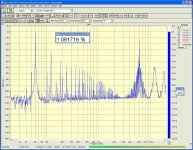 SE KT66 Triode IMD@1W.jpg219.8 KB · Views: 283
SE KT66 Triode IMD@1W.jpg219.8 KB · Views: 283 -
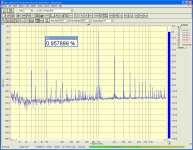 SE KT66 UL THD@1W.jpg207.5 KB · Views: 278
SE KT66 UL THD@1W.jpg207.5 KB · Views: 278 -
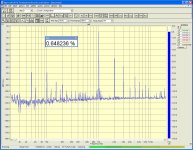 SE KT66 Triode THD@1W.jpg205.4 KB · Views: 272
SE KT66 Triode THD@1W.jpg205.4 KB · Views: 272 -
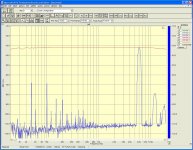 SE KT66 Triode FreqResp.jpg192.4 KB · Views: 761
SE KT66 Triode FreqResp.jpg192.4 KB · Views: 761 -
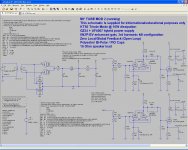 SE KT66 Schematic.jpg347.2 KB · Views: 1,018
SE KT66 Schematic.jpg347.2 KB · Views: 1,018 -
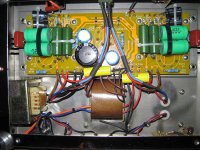 SE KT66 Photo.jpg355.2 KB · Views: 793
SE KT66 Photo.jpg355.2 KB · Views: 793
Last edited:
Adding a bias selector switch
16) Stock version: single value of cathode bias resistor on power tubes
Modification: added a front panel “bright chrome” switch to select among three different BIAS options: HOT, Average , and COLD
This three-positions switch allows you to select among different cathode resistors (connected in parallel) that determine three different BIAS currents and then run the power tubes slight colder or slight hotter than the average.
In Single Ended amplifiers (which always run in Class A) decreasing or increasing the bias current brings little tonal improvement due to the asymmetrical clipping and waveform compression which increases the content of the second harmonic distortion and enhances its ratio compared to the third and odd harmonics.
Bias adjustment is highly recommended after having swapped different tubes or after having changed between Triode and UL mode: you can note in the attached table, coming from my measurements, that different tubes (EL34/6l6GC/KT66) show slight different voltages and consumptions, thus exhibit different tonal behaviours.
Hot bias usually shortens tube life and sound more dynamic and fuller but maybe harsher. Cold bias, for which tubes will last longer, in certain circumstances produces more natural tones, even if sometimes the sound results thin and lifeless.
16) Stock version: single value of cathode bias resistor on power tubes
Modification: added a front panel “bright chrome” switch to select among three different BIAS options: HOT, Average , and COLD
This three-positions switch allows you to select among different cathode resistors (connected in parallel) that determine three different BIAS currents and then run the power tubes slight colder or slight hotter than the average.
In Single Ended amplifiers (which always run in Class A) decreasing or increasing the bias current brings little tonal improvement due to the asymmetrical clipping and waveform compression which increases the content of the second harmonic distortion and enhances its ratio compared to the third and odd harmonics.
Bias adjustment is highly recommended after having swapped different tubes or after having changed between Triode and UL mode: you can note in the attached table, coming from my measurements, that different tubes (EL34/6l6GC/KT66) show slight different voltages and consumptions, thus exhibit different tonal behaviours.
Hot bias usually shortens tube life and sound more dynamic and fuller but maybe harsher. Cold bias, for which tubes will last longer, in certain circumstances produces more natural tones, even if sometimes the sound results thin and lifeless.
Attachments
May I have the schematic for bias adjustment?
Just 1 message upper...
- Home
- Amplifiers
- Tubes / Valves
- Boyuu hifi Equis A10 EL34B+6N2 SE Tube Amplifier with 5Z4P rectifier: review and mod
